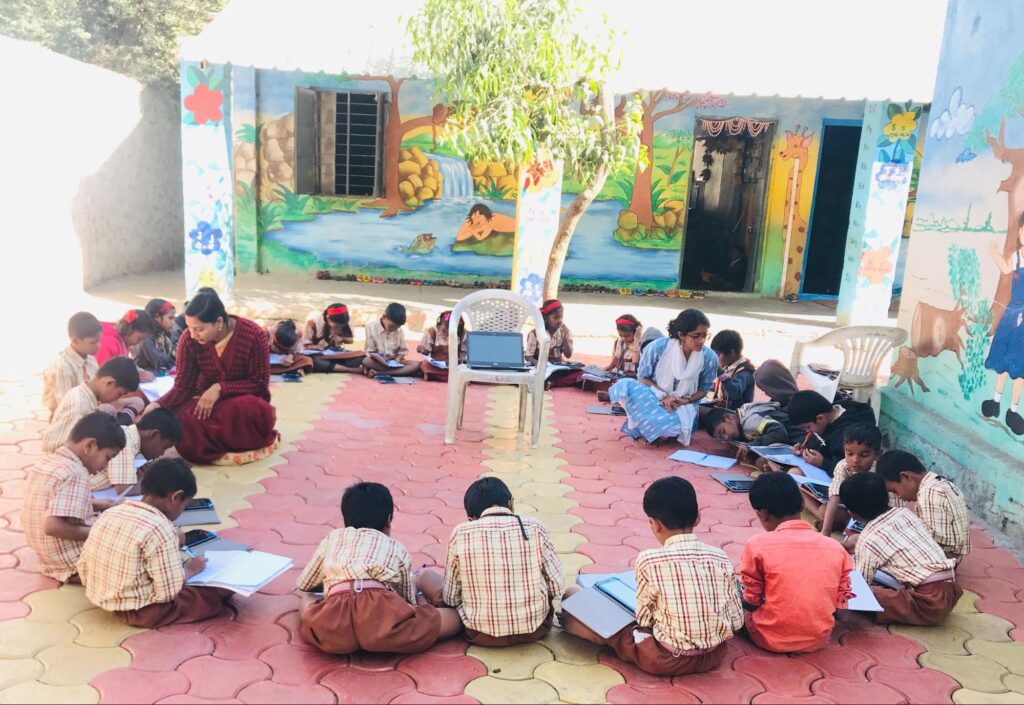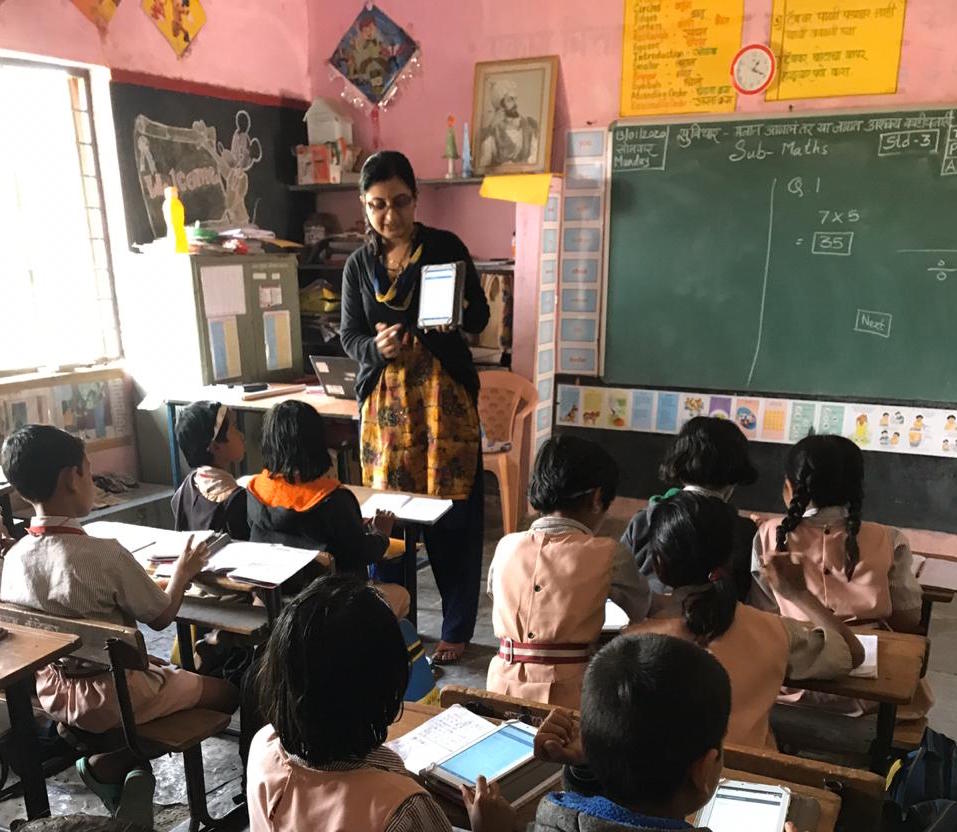
In a small school in Nashik, Maharashtra, most of the students are drawn towards their coming annual day practice, running around for speakers and costumes. However, amidst all this chaos, there is one classroom, where the students are engrossed in navigating through a tablet and solving a math quiz.
To understand what technology integration is, it is often important to know what it is not. Technology integration is not teaching technical skills in silos, where students learn them in isolation. Instead, technology integration refers to technological skills, taught in connection with meaningful activities, that help students understand and implement the same concept on paper and through technology. For example, to learn about measurements, students definitely need to learn the conversion rates between centimeters to meters. However, learning through a personalised learning model facilitated by softwares and devices, helps students’ comprehend and use math concepts more in their day to day lives.
But, why is integrating technology into curricula important in the classroom? Globally, the workplace has drastically changed, and India is now the world’s second largest online market. To ensure that this market penetrates outside of just the country’s urban centres, the Ministry of Information and Technology is now working towards creating digital villages, where information and services related to agriculture, digital education, and healthcare will be received and monitored online. For students in rural schools, who may continue to live in these areas once older, being well-versed with the basics of technology and digital communication is now a necessity. To make this happen, digital literacy skills need to be taught in school from a young age in rural India. This hasn’t been the case so far, though.
As Manoj from Maharashtra’s Lakhalgaon says, “When I was in school, I was never taught how to use a laptop or a computer. Today, I work in a Domino’s outlet where we have to take orders on a computer. It took me five months just to understand the computer and use it effectively. If I was taught the basics in school, maybe I could have joined a bigger firm in a higher capacity.”
So, although many students in urban areas are competent users of technology, students in rural schools still need to make that jump. To bridge this gap, one such technology-focused project in the Zilla Parishad of Nashik (ZP) aims to increase the math learning outcomes of students in rural schools by using a personalised learning model called the ‘Nalanda Project’. The project aims to do so by providing 400 tablets funded by Motivation For Excellence (MFE) to 735 students working out of 5 blocks in Nashik, in 10 semi-English schools with 20 educators. The content provided in these tablets has been curated by the entire team working for the Nalanda Project. For the content to be user-friendly and easily accessible to students of all grades, this ed-tech solution is hosted on the Kolibri platform developed by Learning Equality.
Currently, in these schools, students are only exposed to a television or a projector through which they have limited learning access. Providing students with their own tablets helps them in their long term engagements with technology and digital literacy.
The Policies Behind It All
Digital literacy refers to a particular set of competencies that allow you to function and participate in the digital world and is the focus of the Ministry of Human Resource Development’s plans to transform India’s education ecosystem. These aims are visible in the Draft National Education Policy (NEP).
To minimise rote learning and develop 21st-century skills ranging from scientific temper to digital literacy, the NEP’s objectives for ed-tech are to bring technology integration into all levels of education, and “to support teacher preparation and development; improve teaching, learning and evaluation processes; enhance educational access to disadvantaged groups; and streamline educational planning, administration and management.”
These changes will bring in a clear thought process surrounding technology integration in India, as well as help create clear-cut implementation strategies too. However, for all of this to happen and to actually witness a systemic level change, it is equally important to have disciplined action conducted by disciplined people. In this case, disciplined action refers to the policy implementation of technology integration itself, while the disciplined people are the stakeholders involved, starting from the District Education Officer (D.E.O) to the students. How do we measure these two factors? By simply asking teachers and students how they’re responding to the new changes.
What The Stakeholders Have to Say
Students and educators in rural schools view technology as a scarce and sacred resource, one that they are highly grateful for. Vivek, a student from one of Nashik’s ZP schools shares, “I have always been scared of math. Even when the tabs were brought to school, I wasn’t sure of how much it would excite me. However, to my surprise, I am loving it! Every time there is a tab class, I am happy not just to use the tablet but also to solve all the problems on it.”

However, for these students, their ability to use technology well is only as good as their teachers’ ability to use it. As Rekha, a Grade 4 teacher from ZP Primary School Wadivarhe shares, “Each individual needs to learn the basic skills of digital literacy, however, as a teacher, to impart those skills, it is crucial for me to master them and implement them. I want to be able to learn and develop the best way to teach the students to have online safety skills, communication etiquette, and digital culture. For this, I need to have the required pedagogical and technical skills” Clearly, teacher training through sustained technical, as well as pedagogical support, needs to be the foundation of any investment in technology integration in schools too.
These training sessions would help the teachers with classroom management, effective use of technology, digital literacy, data analysis, and develop disciplined action in the classroom. Keeping these outcomes in mind, employees from Leadership For Equity (through the Nalanda Project) have been conducting training sessions with Nashik’s selected educators to take this project forward.
After taking part in such training sessions, teachers have become more confident in their abilities to implement this project. Vandana, a teacher from Wadivarhe ZP Primary School says, “ I was never keen on being a techno-savvy teacher, I always believed in teaching concepts through the traditional method, however after using technology in class, my perspective has completely changed. I feel more confident to use technology for myself plus for my students. I have seen students in my class not wanting to learn tables or solve mathematical problems to actually asking me to conduct more math+tab classes. This shift has increased the marks obtained by them and their overall interest in the subject.”

As the teachers develop these skills, while they see a readiness to learn amongst students, at times they see resentment too. Some students have been exposed to some form of technology at home, however, a few of them have never even seen a tablet or a laptop. Maya Shinde, a teacher at ZP Primary School Sansari, says “A few of my students come from a tribal setting or belong to migratory tribes. These students have to be taught how to hold a tablet, how to switch it on or off, and how to swipe left-right as well. Some students in my class struggled to get accustomed to this new technology, making the classes longer. But, I also have a few students who have computers and tablets at home. These students become the guiding light for me and the others as well. They are able to help struggling students and grasp new technical skills faster.”
Scaling Ed-Tech Across Indian Schools
Education technology in rural and urban schools is definitely moving fast then, however, due to a host of social and economic factors, it will still take time for its benefits to meaningfully reach every child, whether in rural or urban schools. Technology integration in rural schools requires policymakers and school leaders to co-develop coherent and realistic integration plans at the national, local, and school levels. It can succeed, however, the real questions are what will school level interventions look like, and how sustainable will they be in the long run?
From my observations, tech integration, especially at the rural level, is stuck in a ‘flywheel holding pattern’. The wheel of transformation is churning slowly, but the buildup has not yet generated the necessary momentum to propel a breakthrough in both teaching and learning just yet.
To achieve this breakthrough, three major factors need to be addressed: disciplined thought, disciplined action, and disciplined people. Disciplined thought concerns confronting realities and identifying differentiators, disciplined action concerns the implementation of tech integration in the classroom, and disciplined people refers to institutional leadership and professional development (PD).
As a part of disciplined thought, policymakers, local education agencies, school leaders and educators need to honestly evaluate the balance between ambition and reality. Particular attention must be paid to finances, limitations on educator planning time, and technical support requirements. Considering tech integration on an initial basis takes up a lot of the instructional time, these policy-level changes need to be realistic, implementable, and scalable as well.

Moving on to disciplined action, technology integration should make students confident in using technology and learning academic concepts at the same time. Rather than disregarding traditional teaching methods, technology can be used as a separate academic base upon which skills can be built. For example, while observing for disciplined action, LFE gathered evidence on the balance between technology integration and traditional methods in classes, which led to strong implementation and higher involvement from the students.
Coming to professional development, having monthly training sessions for educators and school leaders s critical as simply introducing additional hardware into classrooms will not succeed if educators are not trained to use them efficiently. As Jayant Jadhav, from ZP Primary School Dugaon, says “The training we receive is not just for today or tomorrow, it’s about enhancing our skills and developing the subject through technology. We learn to develop ourselves as teachers and as a result, all our students move towards technological advancement too.”
Integrating technology with education is definitely the need of the hour, for educators, students, officers, and policymakers. However, it is only through disciplined action that school systems will be able to harness this integration in ways that allow for transformational breakthroughs in student achievements.
Featured image courtesy of Leadership for Equity.







Shivani , well written. Really technology education is required . It’s need to live . Also it boosts the need of skill development. Now we are moving out of textbook education, which is need of an hour . – parag Bandale